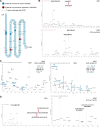Structure-function analysis of CCL28 in the development of post-viral asthma
- PMID: 25556652
- PMCID: PMC4326855
- DOI: 10.1074/jbc.M114.627786
Structure-function analysis of CCL28 in the development of post-viral asthma
Abstract
CCL28 is a human chemokine constitutively expressed by epithelial cells in diverse mucosal tissues and is known to attract a variety of immune cell types including T-cell subsets and eosinophils. Elevated levels of CCL28 have been found in the airways of individuals with asthma, and previous studies have indicated that CCL28 plays a vital role in the acute development of post-viral asthma. Our study builds on this, demonstrating that CCL28 is also important in the chronic post-viral asthma phenotype. In the absence of a viral infection, we also demonstrate that CCL28 is both necessary and sufficient for induction of asthma pathology. Additionally, we present the first effort aimed at elucidating the structural features of CCL28. Chemokines are defined by a conserved tertiary structure composed of a three-stranded β-sheet and a C-terminal α-helix constrained by two disulfide bonds. In addition to the four disulfide bond-forming cysteine residues that define the traditional chemokine fold, CCL28 possesses two additional cysteine residues that form a third disulfide bond. If all disulfide bonds are disrupted, recombinant human CCL28 is no longer able to drive mouse CD4+ T-cell chemotaxis or in vivo airway hyper-reactivity, indicating that the conserved chemokine fold is necessary for its biologic activity. Due to the intimate relationship between CCL28 and asthma pathology, it is clear that CCL28 presents a novel target for the development of alternative asthma therapeutics.
Keywords: Asthma; Chemokine; Disulfide; Mass Spectrometry (MS); Nuclear Magnetic Resonance (NMR); Protein Structure.
© 2015 by The American Society for Biochemistry and Molecular Biology, Inc.
Figures








Similar articles
-
POL7085 or anti-CCL28 treatment inhibits development of post-paramyxoviral airway disease.Immun Inflamm Dis. 2017 Jun;5(2):98-108. doi: 10.1002/iid3.147. Epub 2017 Feb 2. Immun Inflamm Dis. 2017. PMID: 28474501 Free PMC article.
-
The Solution Structure of CCL28 Reveals Structural Lability that Does Not Constrain Antifungal Activity.J Mol Biol. 2018 Sep 14;430(18 Pt B):3266-3282. doi: 10.1016/j.jmb.2018.06.001. Epub 2018 Jun 15. J Mol Biol. 2018. PMID: 29913161 Free PMC article.
-
CCL28 has dual roles in mucosal immunity as a chemokine with broad-spectrum antimicrobial activity.J Immunol. 2003 Feb 1;170(3):1452-61. doi: 10.4049/jimmunol.170.3.1452. J Immunol. 2003. PMID: 12538707
-
CCL28 chemokine: An anchoring point bridging innate and adaptive immunity.Int Immunopharmacol. 2017 Oct;51:165-170. doi: 10.1016/j.intimp.2017.08.012. Epub 2017 Aug 30. Int Immunopharmacol. 2017. PMID: 28843907 Free PMC article. Review.
-
Host epithelial-viral interactions as cause and cure for asthma.Curr Opin Immunol. 2011 Aug;23(4):487-94. doi: 10.1016/j.coi.2011.05.010. Epub 2011 Jun 22. Curr Opin Immunol. 2011. PMID: 21703838 Free PMC article. Review.
Cited by
-
Chemokine CCL28 Is a Potent Therapeutic Agent for Oropharyngeal Candidiasis.Antimicrob Agents Chemother. 2020 Jul 22;64(8):e00210-20. doi: 10.1128/AAC.00210-20. Print 2020 Jul 22. Antimicrob Agents Chemother. 2020. PMID: 32423961 Free PMC article.
-
Small Animal Models of Respiratory Viral Infection Related to Asthma.Viruses. 2018 Dec 1;10(12):682. doi: 10.3390/v10120682. Viruses. 2018. PMID: 30513770 Free PMC article. Review.
-
Chemokines from a Structural Perspective.Int J Mol Sci. 2017 Oct 2;18(10):2088. doi: 10.3390/ijms18102088. Int J Mol Sci. 2017. PMID: 28974038 Free PMC article. Review.
-
Rhinovirus infection of the airway epithelium enhances mast cell immune responses via epithelial-derived interferons.J Allergy Clin Immunol. 2023 Jun;151(6):1484-1493. doi: 10.1016/j.jaci.2022.12.825. Epub 2023 Jan 26. J Allergy Clin Immunol. 2023. PMID: 36708815 Free PMC article.
-
POL7085 or anti-CCL28 treatment inhibits development of post-paramyxoviral airway disease.Immun Inflamm Dis. 2017 Jun;5(2):98-108. doi: 10.1002/iid3.147. Epub 2017 Feb 2. Immun Inflamm Dis. 2017. PMID: 28474501 Free PMC article.
References
-
- Fanta C. H. (2009) Asthma. N. Engl. J. Med. 360, 1002–1014 - PubMed
-
- National Asthma Control Program (2013) Asthma Facts: CDC's National Asthma Control Program Grantees, pp. 1–18, U. S. Department of Health and Human Services, Centers for Disease Control and Prevention, Chamblee, GA
Publication types
MeSH terms
Substances
Grants and funding
LinkOut - more resources
Full Text Sources
Medical
Research Materials

